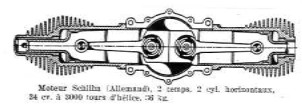Updated: 17-Oct-2023
The Schliha company in Berlin was a motorcycle engine factory. It designed two two-stroke flat twins with double diameter pistons. One gave 34 CV at 3,000 rpm and 36 CV at 3,200 rpm, around 1931.
-It was the Schlüpmannsche Industrie und Handelsgesellschaft.

“Schliha, engine diagrams”
-They had an innovative idea, which was pre-compression that helped sweep and load more efficiently.
-The mixture entered the central crankcase below the cylinders. At the end of the thin pistons there is a crown of holes that is revealed when reaching BDC.

“The diagram is cut to the right”
-As the pistons of the cylinders act in the same way, but in opposite direction, they compress the mixture in the crankcase and cause it to enter the cylinders through the pistons, also sweeping towards the exhaust ports.
-This system causes the pistons to cool internally as the mixture circulates inside them. By having a guide in the head, the pistons do not wear unevenly and therefore the cylinders have an oval shape.
-The latest technical references of the F-1200 were:
cylinder bore 94 mm, piston stroke 100 mm, total displacement 1196 cc. The power varied as follows, 23 CV at 2,200 rpm, the maximum was 36 CV at 3,300 rpm. Consumption 260 gr/CV/Hr.
-A Schliha model F-1200 engine was mounted on an Erla aircraft in 1938.
-It was a horizontally-opposed, twin-cylinder, two-stroke engine.
-In the main text it is presented in a sectioned schematic drawing to see its interior layout. Now we have a photograph.

“Schilha twin-cylinder”
-It gave 36 CV at 3,200 rpm and 40 CV at 3,600 rpm. The manufacturer was Schlupmannsche Industrie und Handelsgesellschaft.
Engines of SCHLIHA
Model: F-1000, 2 cyl. boxer
Arquitecture:
Cooling:
Total Displacement:
Bore / Stroke: x
Power:
Weight:


